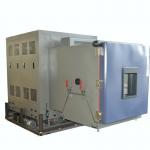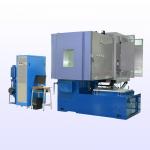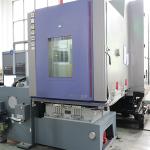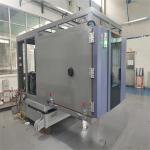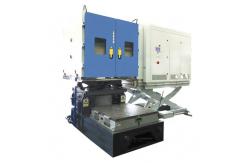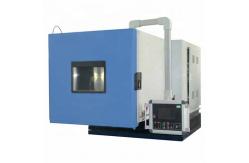In the fast-paced and highly competitive electronics industry, the
reliability and durability of electronic components and devices are
of paramount importance. The Customized Climate Chamber with
Vibration Test is a state-of-the-art solution that allows
manufacturers and researchers to subject electronics to a
comprehensive range of environmental and mechanical stressors,
simulating real-world conditions to optimize product design and
quality. This specialized chamber is designed to evaluate the performance
and integrity of electronic products such as circuit boards,
semiconductors, mobile devices, and aerospace electronics. It
serves electronics manufacturers, aerospace and defense
contractors, research institutions, and quality control
laboratories. The primary goal is to determine how these components
respond to simultaneous temperature, humidity, and vibration
variations, which are common in various applications and during
transportation. By conducting such tests, potential weaknesses can
be identified and addressed, leading to enhanced product
reliability, reduced field failures, and increased customer
satisfaction. - Compact and High-Performance Design
- The chamber is constructed with a rigid and lightweight alloy
framework that provides excellent structural integrity while
minimizing its footprint. The exterior is made of a durable and
corrosion-resistant material, ensuring long-term use in demanding
laboratory or production environments. The interior is lined with
an electrostatic dissipative and thermally conductive material to
prevent electrostatic discharge and promote uniform temperature
distribution. The door features a precision sealing mechanism,
incorporating a conductive gasket and a secure locking system,
maintaining a stable and controlled testing environment. A small
but high-resolution viewing window, made of anti-static and
anti-glare glass, allows for visual inspection without interfering
with the internal conditions. The chamber is also equipped with
adjustable racks and holders to accommodate different sizes and
shapes of electronic samples.
- Precision Environmental and Vibration Control Systems
- Temperature Control: Capable of maintaining a wide temperature
range, from -60°C to +150°C, with an accuracy of ±0.3°C. It
utilizes advanced thermoelectric cooling and heating technologies,
which offer rapid temperature transitions and excellent temperature
uniformity. The control system is equipped with a high-resolution
feedback loop, featuring multiple temperature sensors strategically
placed within the chamber to ensure minimal temperature gradients.
The user-friendly control panel permits the programming of
intricate temperature profiles, including rapid temperature ramps,
extended soak times at specific temperatures, and cyclic
temperature sequences, all of which are essential for mimicking
real-world temperature variations such as those experienced during
device operation, transportation, and storage.
- Humidity Control: The humidity control system is equally precise,
capable of achieving humidity levels from 5% to 95% RH (Relative
Humidity), with an accuracy of ±2% RH. It utilizes a combination of
ultrasonic humidifiers and desiccant dehumidifiers, integrated with
a carefully designed laminar air flow system. This ensures uniform
humidity distribution and rapid humidity adjustments. The chamber
is outfitted with highly accurate capacitive humidity sensors that
continuously monitor the internal humidity, and the control system
makes real-time adjustments to maintain the desired humidity
levels. This is crucial for testing the effects of moisture on
electronic components, such as the potential for corrosion,
short-circuiting, or degradation of electrical properties.
- Vibration Control: The vibration system is a high-precision
component, capable of generating a wide range of frequencies and
amplitudes. It can produce vibrations from 2 Hz to 2000 Hz, with
amplitudes adjustable from 0.05 mm to 50 mm. The vibration table
within the chamber is designed to provide a highly uniform and
controlled vibration field, ensuring that all parts of the tested
component experience the same mechanical stress. The control system
allows for the programming of complex vibration waveforms,
including sinusoidal, random, and shock waveforms, mimicking the
diverse vibration patterns that electronic components encounter,
such as those caused by transportation vibrations, machinery
operation in industrial settings, or the vibrations experienced in
aerospace applications. The vibration system is also equipped with
accelerometers and displacement sensors to accurately measure and
monitor the applied vibrations, ensuring the repeatability and
accuracy of the tests.
- Advanced Instrumentation and Data Acquisition
- The chamber is outfitted with a comprehensive suite of sensors and
instrumentation. In addition to temperature, humidity, and
vibration sensors, it includes sensors for measuring electrical
parameters such as voltage, current, resistance, and capacitance of
the tested electronic components. These sensors are connected to a
state-of-the-art data acquisition system that records and stores
all relevant data. The data acquisition system offers a high
sampling rate, typically ranging from 1000 to 5000 samples per
second, ensuring that even the most rapid changes in environmental
conditions, vibration parameters, or component performance are
accurately captured. The collected data can be accessed and
analyzed in real-time or retrieved later for in-depth studies. The
system is also compatible with specialized electronics industry
data analysis software, enabling the generation of detailed reports
and graphical representations of the test results, which are
essential for making informed engineering decisions.
- Enhanced Safety and Compliance Features
- The Customized Climate Chamber with Vibration Test for the
Electronics Industry is designed with multiple safety features. It
incorporates an automatic emergency shutdown system that activates
immediately in the event of any critical malfunction, such as
overheating, overcooling, excessive humidity, or a vibration system
failure. The chamber is equipped with a fire suppression system,
which can quickly extinguish any potential fires that may occur due
to electrical faults or component failures. The ventilation system
is engineered to remove any harmful gases or fumes that may be
generated during the testing process, protecting both the samples
and the operators. The control panel is designed with safety
interlocks and clear warning indicators to prevent accidental
operation and ensure the well-being of personnel. Additionally, the
chamber complies with all relevant electronics industry standards
and regulations, such as IEC 60068 for environmental testing and
MIL-STD-810 for military electronics testing, ensuring that the
testing procedures are recognized and accepted by regulatory bodies
and industry stakeholders, facilitating the certification and
market acceptance of electronic products.
- Chamber Size and Capacity: The chamber is available in a variety of sizes, from small
benchtop models with a volume of a few liters, suitable for testing
individual microchips or small circuit boards, to larger
floor-standing units with volumes up to several cubic meters,
capable of accommodating multiple racks of server components or
complete consumer electronics devices. The interior dimensions are
optimized for proper air circulation and uniform distribution of
environmental and vibration parameters, ensuring that all parts of
the tested electronics are effectively exposed to the simulated
conditions.
- Temperature Cycling Rate: The chamber can perform temperature cycles at a rate of 3 to 6
cycles per hour, depending on the specific requirements of the test
protocol. For example, it can rapidly cool from +80°C to -40°C in a
matter of minutes and then heat back up, subjecting the electronic
components to significant thermal stress. The ramp rate can be
adjusted, typically ranging from 2°C per minute to 15°C per minute,
allowing for the simulation of different thermal profiles.
- Humidity Cycling Rate: The humidity can be cycled within 10 to 20 minutes, allowing for
the simulation of rapid changes in moisture conditions. This
replicates the transitions that may occur, for example, when an
electronic device is moved from a dry indoor environment to a humid
outdoor one or vice versa. The chamber can quickly adjust the
humidity level from a low value, such as 10% RH, to a high value,
such as 90% RH, and back, enabling the evaluation of the
component's response to such changes.
- Vibration Frequency and Amplitude Range: The vibration system can generate frequencies from 5 Hz to 1000
Hz, with amplitudes adjustable from 0.1 mm to 20 mm. These
parameters are suitable for simulating a wide range of vibration
conditions that electronics may face, from the relatively
low-frequency vibrations of a shipping container in transit to the
higher-frequency vibrations of a nearby operating machinery.
- Data Acquisition Rate: The data acquisition system samples sensor data at a rate of 3000
samples per second, ensuring that even the slightest and most rapid
changes in temperature, humidity, vibration, or electrical
parameters during the test are accurately recorded. This high
sampling rate provides engineers and scientists with detailed and
accurate information about the performance and behavior of the
tested electronics, enabling them to identify potential issues and
make informed design improvements.
- Compliance with Industry Standards: The chamber is fully compliant with IEC 60068, which covers a
wide range of environmental testing methods for electronics, and
MIL-STD-810 for military electronics testing. This compliance
ensures that the testing is conducted in accordance with the strict
requirements and procedures established by the electronics
industry, providing confidence in the reliability and performance
of the tested products.
- Accurate Simulation of Electronics Operational Environments
- The primary function of this chamber is to provide a highly
accurate and realistic simulation of the environmental and
vibration conditions that electronic products will face during
their operational lifespan. By precisely controlling temperature,
humidity, and vibration levels, it allows for the evaluation of how
components and devices will perform and degrade over time. For
example, it can determine if a smartphone's touchscreen will
malfunction due to condensation in a humid environment or if a
computer's motherboard will experience component failures due to
overheating and vibration during transportation. It can also assess
how a satellite communication system's electronics will fare in the
vacuum and vibration environment of space. This information is
invaluable for electronics engineers to optimize their designs,
select appropriate materials, and improve the overall reliability
and durability of their products.
- The ability to conduct repeatable tests with different
environmental and vibration profiles, as mandated by industry
standards, is also a crucial function. This helps in comparing the
performance of various product designs or manufacturing processes
and identifying the most suitable solution. For instance, a
semiconductor manufacturer can test multiple prototypes of a new
chip under the same set of temperature, humidity, vibration, and
electrical stress cycling conditions and analyze the results to
select the most reliable and efficient design.
- Enhanced Electronics Product Quality and Innovation
- Through comprehensive testing in the Customized Climate Chamber
with Vibration Test, electronics product developers can identify
and address potential issues in their designs. If a component shows
signs of failure or degradation during the test, appropriate
measures can be taken, such as modifying the material composition,
improving the manufacturing process, or adding protective coatings
or shielding. This leads to the development of more reliable and
durable electronics products, reducing the risk of product recalls
and enhancing customer satisfaction. In the research and
development field, it allows for the exploration of new materials
and technologies, providing valuable data on their behavior under
extreme environmental and vibration conditions. For example,
researchers can study the performance of new graphene-based
conductors in high-temperature, high-humidity, and vibrating
environments or the effectiveness of novel EMI shielding materials.
- The chamber also serves as a powerful tool for quality control. By
subjecting products to standardized environmental and vibration
tests, manufacturers can ensure that their products meet the
required quality and performance standards. This helps in building
a reputation for quality and reliability in the highly competitive
electronics market, which is essential for winning customer trust
and market share.
- Compliance with Electronics Industry Standards and Regulations
- The compliance of the test chamber with relevant electronics
industry standards is a key aspect of its functionality. The
electronics industry is highly regulated, and products must meet
specific standards to be accepted for use. By using this chamber to
conduct tests in accordance with standards like IEC 60068 and
MIL-STD-810, manufacturers can prove that their products are safe
and reliable. Regulatory bodies and industry customers rely on
accurate test results obtained from such chambers to enforce safety
and quality regulations, ensuring the proper functioning of
electronic products and the protection of consumers and other
electronic systems.
|
